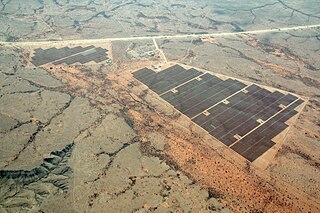
A power station, also referred to as a power plant and sometimes generating station or generating plant, is an industrial facility for the generation of electric power. Power stations are generally connected to an electrical grid.

Renewable energy plays an important and growing role in the energy system of the European Union. The Europe 2020 strategy included a target of reaching 20% of gross final energy consumption from renewable sources by 2020, and at least 32% by 2030. The EU27 reached 22.1% in 2020, up from 9.6% in 2004, but declined to 21.8% in 2021. These figures are based on energy use in all its forms across all three main sectors, the heating and cooling sector, the electricity sector, and the transport sector.

Ruacana is a town in the Omusati Region of northern Namibia and the district capital of the Ruacana electoral constituency. It is located on the border with Angola on the river Kunene. The town is known for the picturesque Ruacana Falls nearby, and for the Ruacana Power Station.
Oglethorpe Power Corporation is a medium-sized electric utility in Georgia, United States. Formed in 1974, Oglethorpe is a not-for-profit cooperative owned by the 38 electric membership corporations that it serves. The utility's headquarters are in Tucker, Georgia.
Zimbabwe Electricity Supply Authority, (ZESA) whose official name is ZESA Holdings (Private) Limited, is a state-owned company whose task is to generate, transmit, and distribute electricity in Zimbabwe. It has organized this task by delegation to its subsidiaries, the energy generating company Zimbabwe Power Company (ZPC) and the Zimbabwe Electricity Transmission and Distribution Company (ZETDC). Other subsidiaries are the investment branch ZESA Enterprises (ZENT) and internet provider PowerTel Communications (Private) Limited. ZESA is the only electricity generator and supplier for the public grid. For many years the company has failed to produce enough energy to meet demands. ZESA produced an estimated 6.8 billion kWh in 2016, while demand was estimated at 7.118 billion kWh. ZESA represents Zimbabwe in the Southern African Power Pool.
According to the International Hydropower Association, Canada is the fourth largest producer of hydroelectricity in the world in 2021 after the United States, Brazil, and China. In 2019, Canada produced 632.2 TWh of electricity with 60% of energy coming from Hydroelectric and Tidal Energy Sources).
The Caluequee Dam, is an operational multipurpose dam across the Kunene River, in Kunene Province, in southwestern Angola. The dam stores water for the 347 MW (465,000 hp) Ruacana Hydroelectric Power Station, in neighboring Namibia. Its waters are also used for the irrigation of farmland, both in Angola and Namibia.
The Ruacana Hydroelectric Power Station is a hydroelectric power plant near Ruacana in northwest Namibia, close to the Angolan border. Commissioned in 1978, it is by far the largest power station in Namibia. Its operator is NamPower, the Namibian national electric power utility company.

The electricity sector in Sri Lanka has a national grid which is primarily powered by hydroelectric power and thermal power, with sources such as photovoltaics and wind power in early stages of deployment. Although potential sites are being identified, other power sources such as geothermal, nuclear, solar thermal and wave power are not used in the power generation process for the national grid.

Copperbelt Energy Corporation Plc (CEC) is a Zambian electricity generation, transmission, distribution and supply company with operations in Zambia and Nigeria. The company is listed on the Lusaka Stock Exchange
Burning of charcoal and wood fuel provides approximately 94 percent of the energy in Malawi. Much of the renewable hydroelectric potential of the country is untapped. As per 2018 Population and Housing Census, the national electrification rate in Malawi was 10%, with 37% of the urban population and only 2% of the rural population having access to electricity.
The Electricity Generation Company Malawi Limited (Egenco) is a parastatal company whose primary purpose is to generate electric power for use in Malawi and for possible sale to neighboring countries. As of April 2018, Egenco's generation capacity was 351 megawatts (471,000 hp). In May 2021, Egenco's generation portfolio increased to 441.55 megawatts (592,130 hp), when the 19 MW Tedzani IV Hydroelectric Power Station, was brought online.
Zambia is potentially self-sufficient in sources of electricity, coal, biomass and renewable energy. The only energy source where the country is not self-sufficient is petroleum energy. Many of the sources of energy where the country is self-sufficient are largely unexploited. As of 2017, the country's electricity generating capacity stood at 1,901 megawatts.
The Baynes Hydroelectric Power Station is a planned 600 megawatts (804,613 hp) hydroelectric power plant in northwest Namibia, at the border with Angola.
The Matala Power Station is a hydroelectric power station across the Kunene River, in Angola, that has installed generation capacity of 40 MW (54,000 hp). The power station came online in 1954.

The Mariental Solar Power Station is a 45.5 MW (61,000 hp) solar power plant in Namibia. The project is owned and was developed by a consortium of various IPPs and the Namibian electricity utility company, NamPower.
The Khan Solar Power Station, is a 20 megawatts (27,000 hp) solar power plant under construction in Namibia. The project is owned and under development by Access Aussenkehr Solar One Namibia a Namibian independent power producer (IPP), based in Windhoek, the country's capital city. The energy generated here will be purchased by NamPower, the national electricity utility company, which is wholly owned by the government of Namibia. A 25-year power purchase agreement (PPA), governs the terms under which the energy will be sold and bought.
The Diaz Wind Power Station, is a 44 MW (59,000 hp) power plant under construction in Namibia. The power station is under development and is owned by Diaz Wind Power, a joint venture company owned by (a) United Africa Group and (b) Quantum Power. The energy generated at this wind farm will be sold to NamPower, the national electricity parastatal company of Namibia, under a 25-year power purchase agreement (PPA).
The Omburu Solar Power Station, is a 20 megawatts solar power station in Namibia. The power station, which was developed and is owned by Namibia Power Corporation (Proprietary) Limited (NamPower), was constructed between March 2021 and June 2022 and was commercially commissioned on 24 June 2022. NamPower integrates the energy generated here, calculated at 67.8 GWh annually, into the Namibian grid. This is the first grid-connected PV solar power station, fully owned and operated by NamPower.
The Rosh Pinah Wind Power Station, is a planned 40 MW wind-power plant in Namibia. The wind farm is under development by Namibia Power Corporation Limited (NamPower), the Namibian electricity parastatal company. This wind farm is intended to increase Namibia's energy generation mix. An environmental impact assessment study by the consulting firm Enviro Dynamics, has been ongoing since 2020 and will inform the management of this renewable energy project.









